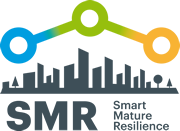Policies
Indicators
Number of awareness raising events targeting CITY stakeholders
Description
Cross-sectoral meetings are held with different stakeholders, to inform, invite feedback and exchange knowledge.
Case studies
Further information
 Relevant city context
Relevant city context
The case study applies to all cities and towns developing a resilience action plan, including activities such as risk assessment and local stakeholder engagement.
Goals: increase engagement in building community awareness on urban resilience with local stakeholders; assessment of systemic risks
The City of Rome are setting an agenda for a resilience action plan, mainly led by the city’s Urban Planning Department,”Risorse per Roma”. It has been a challenge to define and operationalize the complex concept of resilience in the city, and one of the main topics has been to make a systemic risks assessment to identify interdependencies and vulnerabilities. The assessment has been made through interviews and workshops with policymakers, practitioners and local stakeholders of different departments, at both Local and Regional Authorities. Further. Scenarios were used to fuse the discussion during the focus groups, leading to the identification of interdependencies between risks at a local level. As described by the involved stakeholders, one of the greatest challenges was the vicious circles arising from the lack of coordination among sectors of the public administration (e.g. the water management). The challenge is viewed as a particularly challenging issue for the city of Rome, due to the large territory and population under a single municipal jurisdiction.
Cooperation between stakeholders
Through the multidisciplinary focus groups, the cities municipality, local stakeholders and scientists had the opportunity to develop a mutual learning process based on each other’s knowledge and skills. In developing strategies to promote urban resilience the Urban Planning Department and Risorse per Roma highly appreciated the practical expertise of the local stakeholders involved, as well as the support from scientific partners in the SMR project. Having representation form the people who normally “get the job done” was regarded as highly important for the success of the workshop. Further, the accomplishments of the focus groups indicated the presence of strong political leadership and inter-departmental coordination.
Outcomes
Discussions from the stakeholder interviews and focus groups contributed to the assessment of systemic risks the city is facing. The municipality and workshop participants felt that discussions led to increased awareness of hazard risk groups and helped improve community and government capacity to identify and implement risk reduction strategies. Eight main areas for further work were identified during the focus groups and are summarized below. Next steps include making priorities and identifying opportunities for new policies and project funding. The final outcome of the project will be to lay the foundations for the establishment of a special Urban Resilience Office, to act as a Control Room for the Resilience policies of Rome.
- Abandoned Public/Private Real Property: Abandoned Real Property is a cost and a constraint to urban development; this should lead to a re-thinking of public services and new forms of housing and productive activities
- Cultural Heritage and Natural Resources: Rome has a high number of resources, sometimes poorly integrated into the life of the city; moreover, the impact of climate and anthropogenic risks on fragile, unique and, above all, unreplaceable assets must be considered
- Vulnerable Population: In terms of social-demographic challenges such as aging population, new immigrants, exclusion, poverty, family ties changes
- Critical Infrastructures: The city's infrastructure system – namely the public transport system - is highly vulnerable due to uninterrupted heavy stress conditions and the lacking of sufficient redundancy
- Immigration: The challenge arises from the impact of immigration waves on the ordinary urban management, putting pressure on a public service system already under heavy stress conditions
- Terrorism: The city has got high symbolic value because of its touristic appeal and its proximity to immigration routes. However, compared to other EU capitals, Rome has no secluded communities, leading to a better monitoring of the territory
- Climate Change: In the case of Rome, effects of climate change are relevant to increasing flash floods and heat waves. These two risks are amplified because of an aging population and the extremely fragile cultural-historic heritage
- Governance and Participation: A rational use of significant resources of data, experience, know-how must be developed; the social capital of the city, though abundant in forms of active citizenship, is neither systemic nor adequately recognized.
Resources
Funding for the project has come from EU-project funding (SMR Project) and the 100 RC network. EU SMR funding: 147.000 € approx. (2015- 2018), 100RC funding: 40.000 € approx. (2015-2018)
Other
See here the Resilience Workshop of Rome (“Il workshop di Roma”): http://www.urbanistica.comune.roma.it/smr/workshop-roma2016.html
Subscribe to our newsletter

This project has received funding from the European Union’s Horizon 2020 research and innovation programme under grant agreement no. 653569.
